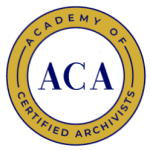Ten Years After: Reflections on the Academy’s First Year
By Gregory S. Hunter, CA
Long Island University
Founding President, Academy of Certified Archivists
Could ten years have passed so quickly? Can ACA possibly be entering its second decade of existence? Since when did I become an elder statesman of the profession? These and other questions came to mind when Susie Maclin asked me to write a newsletter article reflecting on the first year of ACA.
The 1989 SAA Annual Meeting in St. Louis began much like its predecessors. There were meetings of committees, task forces, and affinity groups (as I believe they were called at the time). What was unprecedented was the evening meeting to officially form ACA. Up until this point, SAA’s Interim Board for Certification (IBC) had been responsible for the profession’s accreditation process. IBC had coordinated the certification-by-petition process and had developed the first accreditation examination. IBC now was ready to transfer responsibility to the new Academy of Certified Archivists.
It may be hard to believe, but the first class of certified archivists came to St. Louis without knowing who their leaders would be for the year. The first order of business at the inaugural ACA meting was to elect officers. Before the meeting, two candidates were nominated for each of the four offices – – but the election was to take place at the meeting. This guaranteed that whoever was elected would begin the year without a well-developed plan of action.
When the votes were tallied, the first ACA officers were:
* David Olson, Vice President
* Karen Benedict, Treasurer
* Karen Paul, Secretary
* and myself as President.
I remember being shocked and overwhelmed at the responsibility. The four of us agreed to meet for breakfast to decide how we would approach our year in office.
When I returned to my room that night, I started thinking about what I would suggest to the other three officers the next morning — after all, as president I was expected to “preside” at the meeting and shape the agenda. I used a yellow legal pad to outline responsibilities for each officer. Since we had no Board of Regents, I had concluded that each officer would need to take responsibility for a major area of ACA.
At our breakfast meeting we agreed on responsibilities. I would work on ACA’s incorporation and the preparation of a constitution and by-laws. David would coordinate the completion of the certification by petition process and the administration of the next examination. Karen Benedict would set up the financial control system and determine the best way to manage ACA’s funds. And Karen Paul would prepare the member newsletter and promote ACA and the value of certification.
Each officer had his or her own particular challenges. Surprising as it may be, ACA was not incorporated at the time of the St. Louis meeting. The four officers, in effect, could have been personally liable for decisions that they made. I worked closely with outside counsel to prepare a constitution and by-laws and to get the organization incorporated. I also was responsible for establishing an ACA office, at that time at the SAA office.
David spent much of the year on certification petitions and the appeal of negative decisions. While in theory these should have been completed before ACA’s formation, the sheer volume of petitions guaranteed that the process would take longer than anyone had anticipated. Frank Cook has in the ACA Archives one of the Hollinger boxes that we used to mail petitions back and forth. The condition of the box attests to both the quality of the product and the miles that it traveled via the U.S. Postal Service.
Karen Benedict faced the challenge of establishing a financial control system from scratch and figuring out how to make ACA’s initial funds from certification last as long as possible. (At the beginning there were no annual dues.) The situation was compounded by the fact that IBC’s procedures required ACA to reimburse SAA for the costs of developing certification over the previous few years.
Karen Paul, in promoting ACA, had to face first hand the divisiveness that the certification process caused in the archival profession. As a way of trying to heal the wounds, we decided to publish the ACA newsletter as an insert in the SAA newsletter. We thought this was the easiest way to communicate regularly with the wider archival profession.
Well, we did manage to survive the many challenges of the first year. In my own case, I also had a career change: I left ITT Corporation mid-year to teach at Long Island University, leaving my secretarial support in the process. At the 1990 SAA Annual Meeting, the offices again gathered for a meal — this time to celebrate a year of hard work and a trust fulfilled to the best of our abilities. That night I expressed to David, Karen, and Karen how lucky I felt that the membership has chosen them to lead ACA that first year. Never before or since have I seen three people work harder and dedicate themselves so completely to a professional task. By this article, I am happy to be able to add my “thank you” to ACA’s official records.
Happy Birthday, ACA!
I wish you many more decades of advancing the important profession of archivist.
